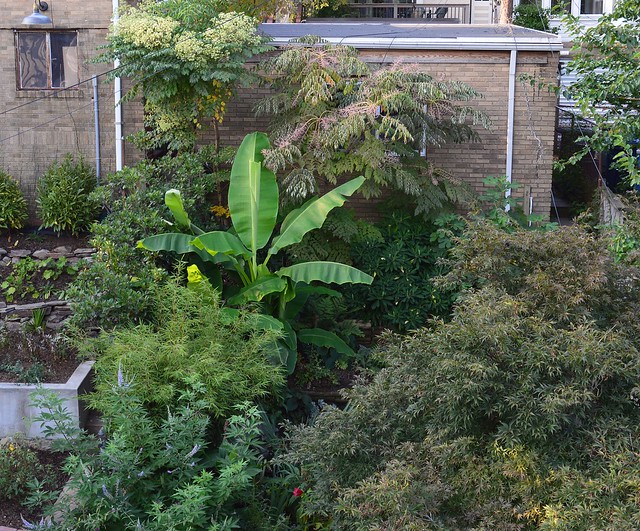
August 2015: no more windmill palms
I've always been interested in testing the limits of marginally hardy plants, plants that are new to cultivation, and plants whose hardiness is otherwise unknown. For better or for worse, my last two winters have been very good ones for testing hardiness! The low temperature in my back yard in Washington, DC (zone 7a) during both winters was about 5 degrees (-15° C), my area's coldest temperatures in 20 years. Despite the similar low temperatures, the two winters were very different in terms of wind, snow cover, and timing and duration of the cold. Several plants that survived the first of the two winters didn't make it through the second; in some cases I think they were weakened going into the second winter, but I also think the ground froze more deeply, doing more damage to otherwise healthy plants.
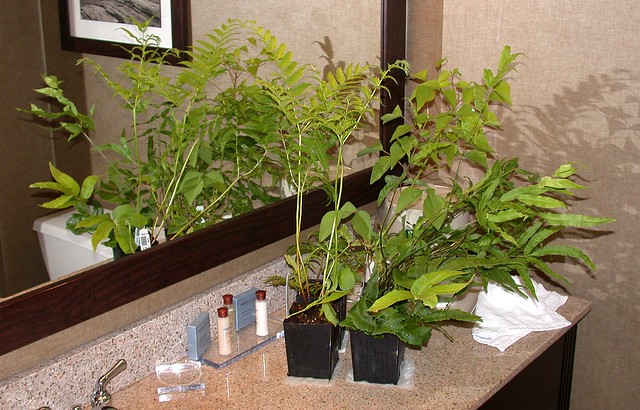
Plant Delights purchases, August 2014
I try new plants every year, some more successfully than others. I figure the failures just make space to try something new! Many (but not nearly all) of my new plants have come from Plant Delights Nursery in Raleigh, North Carolina and many are relatively new introductions whose hardiness is still unknown. I don't coddle anything, and my protection was the same for both winters: a light mulch of leaf compost, with an additional 2-4 inches of loosely piled autumn leaves. With a few exceptions, the plants I mention below had all survived the 2013-2014 winter, which at the time was my area's coldest winter since 1994. Getting two cold winters in a row put these plants to a much more rigorous test. In the 2015 photos below you'll spot some of the survivors, and in my next blog post I'll report on the winners.

Trachycarpus fortunei "Bulgarian", December 2013
The biggest disappointment was the loss of my last windmill palm, Trachycarpus fortunei "Bulgarian". In the ground since 2007 or so (see Palm progress, 2009-2013), this palm had done phenomenally well, growing fast and never suffering winter damage... until January 2014. It was the only one of my 3 windmill palms to survive that winter, its fronds showing damage much later than the other two and unlike them, retaining some green until spring. Although its fronds did eventually die, it put out a few new leaves during the growing season and even attempted to bloom (I removed the young inflorescences to divert its energy towards producing new fronds). Considering the extent of the damage, and the death of my other two windmill palms, its survival was rather remarkable. This was one of 2014's winners (See Bulgarian wins!) but I knew that, in its weakened state, a second cold winter in a row would probably kill it, and I was right. It defoliated again, and this time it didn't come back.
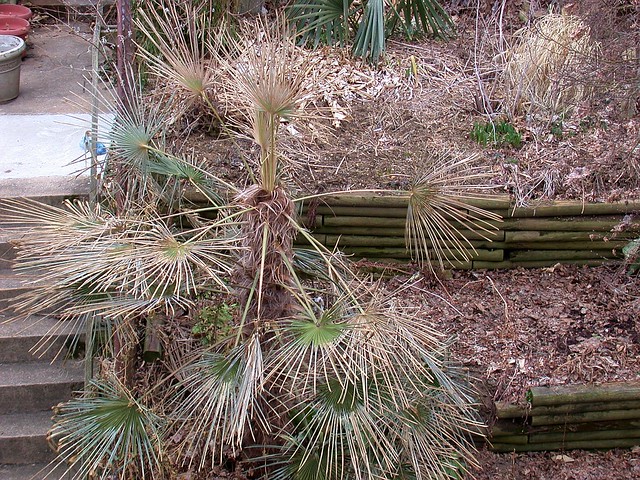
March 2014 (all these leaves eventually died)

November 2014, partial recovery
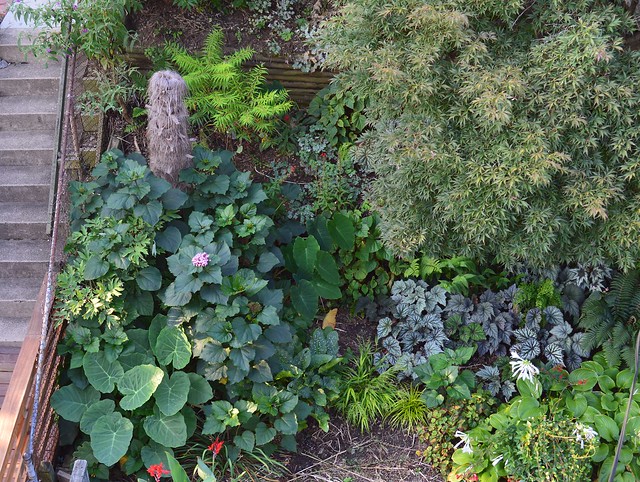
August 2015: dead
I wrote extensively about hardy palms during the first few months of this blog, and I've had several people ask me recently if I've given up on windmill palms. I plan a major overhaul of my garden next year, and I wouldn't rule out a new palm or two. I still think they're worth growing here; even without protection, they can easily last 10, 15 or even 20 years before one of our inevitable cold winters kill them. The main obstacle for me is figuring out where to squeeze them in, and my small urban garden doesn't have a lot of space.
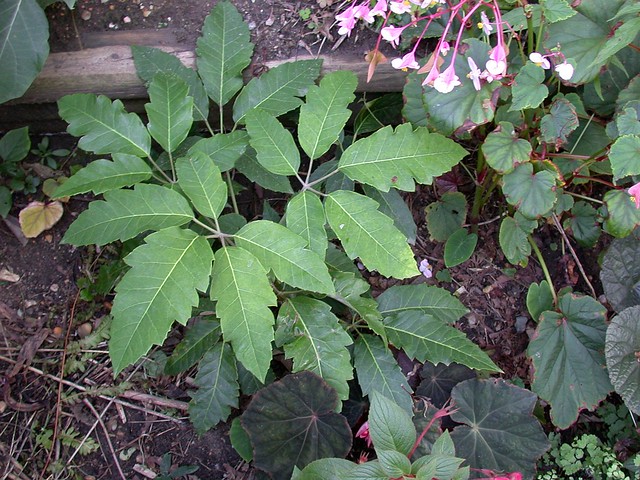 Schefflera delavayi (October 2014)
Schefflera delavayi (October 2014)I planted Schefflera delavayi in August 2013, shortly after purchasing it on a visit to Plant Delights. Despite the late planting, it survived the cold 2013-2014 winter with some light protection. Although it didn't gain any height, it put out healthy-looking foliage last year. Despite a heavy mulch of autumn leaves, the whole thing fried to the ground and didn't come back from the roots as it has for some other people who are growing it in zone 7. I may try this one again, and hope for a warmer winter.

Cycas panzhihuaensis (January 2015)
One long-term survivor I lost was Cycas panzhihuaensis, a rare hardy cycad from China. I received this plant as a small seedling from a friend in 2005, and planted it out in 2006 after it had grown a bit bigger. Although it defoliated every winter--some with high single digits--it came back every spring and initially did quite well, growing more and bigger fronds each year despite being shaded out by other plants. It began to decline after I transplanted it to a sunnier spot but even so, it survived the 2013-2014 winter, growing weakly at first but sending out a couple of bigger fronds later in the year. The leaves stayed green well into the winter but eventually died when temperatures dropped below the low teens in January 2015. It didn't come up this spring so the second cold winter seems to have finished it off. I haven't completely given up hope; cycads are famous for returning from the (seemingly) dead so I haven't disturbed it to see if the subterranean stem is still alive.
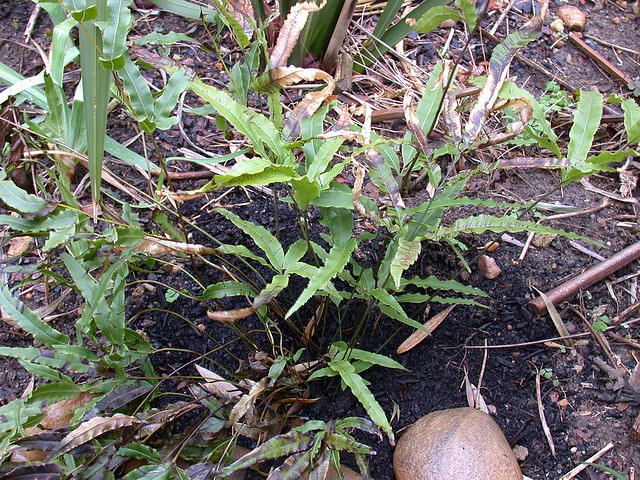
Pteris cretica var. nervosa 'Wu Wu', January 2015
I lost just one fern, Pteris cretica var. nervosa 'Wu Wu', a Plant Delights collection from Sichuan, China. Pteris cretica is generally considered hardy only to zone 8. The Plant Delights catalog rates 'Wu Wu', a high elevation collection, as hardy to zone 7b "guessing". The fronds stayed green well into the winter, not frying until temperatures got into the low teens so I suspect it would survive a warmer winter. I got this plant in the ground rather late in the growing season (August) so with better establishment and heavier mulching, it might have made it. I like the look of this fern so this is another one I may try again.
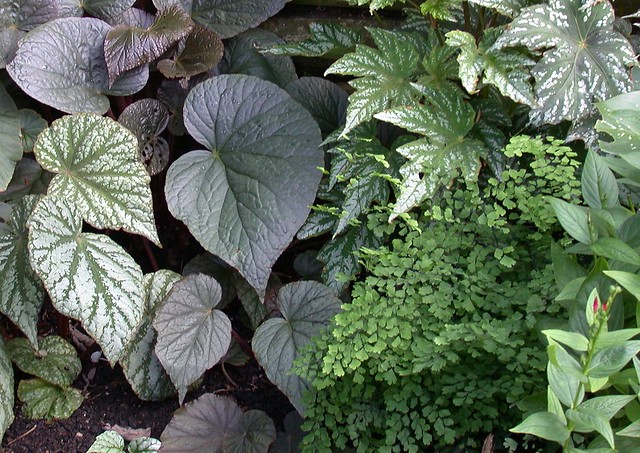
Begonias: no survivors here
My begonias took a particularly hard hit, both species and hybrids (including some of my own crosses). Considering how many had survived the previous cold winter, and how vigorously they came back, I was truly shocked to lose so many of them. This is an instance where I think the ground froze a little more deeply than the previous year, killing the rhizomes. With the exception of B. grandis and a few others I'll discuss in my "winners" blog post, the begonias I described last year in Hardy begonias: the next generation have failed to return. Among the losses were B. chitoensis, B. deliciosa, B. palmata, 'Charles Jaros', 'Helen Teupel', 'Taconite', and U475. I was especially disappointed to lose two beautiful begonias that had otherwise proven both hardy and vigorous, 'Caribbean Star' and U508.
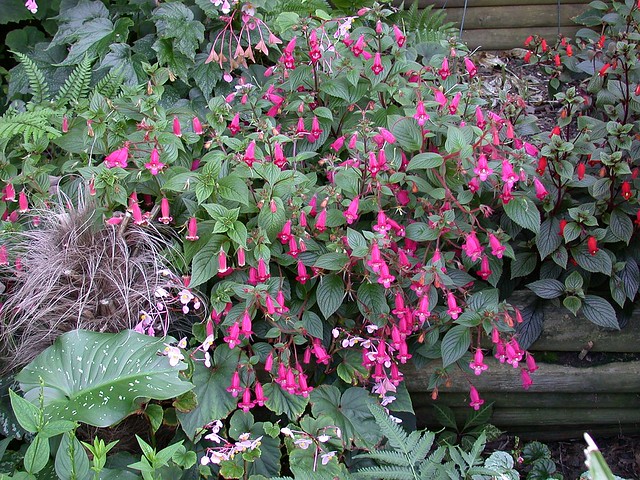
Seemannia hybrids, all gone
I probably shouldn't even mention Seemannia here, because none of them have ever survived any but the warmest winters; I had S. nematanthodes 'Evita' and S. gymnostoma come back one spring after a winter whose lowest temperature was 18° (-8 C). Probably not coincidentally, both were also growing in particularly well-drained pockets of soil, something my garden doesn't have a lot of. Nonetheless, I was disappointed that of the plants I left in the ground, complex hybrids involving several species and representing a considerable shuffling of their genes, not a single one had the right genetic combination to survive a cold winter. Tony Avent tells me that my Seemannia 'Little Red' has been reliably hardy for him at Plant Delights (zone 7b) but my zone 7a garden is apparently just a bit too cold (and heavy clay-based soil certainly doesn't help).
20 year old specimen of Ginkgo biloba (2013)
Finally, I lost two plants that were growing in pots on my roof deck. Because potted plants are much more susceptible to cold I wouldn't even mention these, except that one of them was Ginkgo biloba, a tree that's supposed to be hardy to zone 4. Even worse, it was a 22 year old specimen that I had grown from seed I collected myself from a tree in DC shortly after moving here. I still remember cleaning the seeds because I ended up with horrible dermatitis from handling them! I had maintained it as a dwarf by hard pruning, and had overwintered it outdoors without any protection in previous years without any trouble. This time around, the roots must have frozen and died because shortly after the buds broke in the spring, the new leaves abruptly wilted and died before even expanding. The other potted tree I lost was Firmiana simplex, a bit less surprising as this species is marginally hardy in zone 7; I was surprised it survived the 2013-2014 winter.
Despite my losses, all is not doom and gloom! I've had some survivors, including a couple of surprising ones. I'll write about those in follow-up blog post in a couple of days.

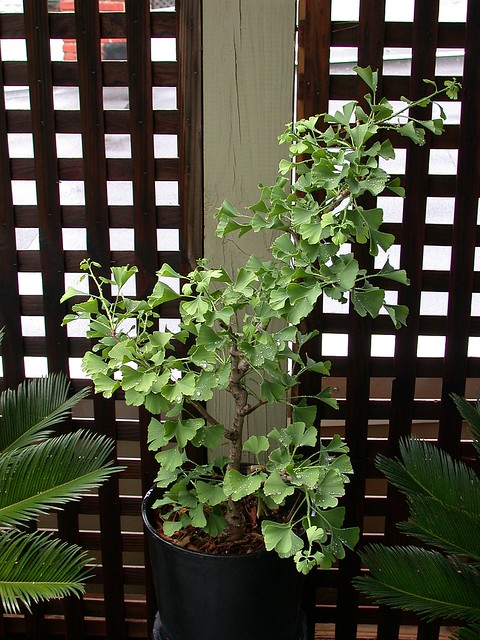
You've certainly brought me out of my summer stupor and face to face with winter's cold hard reality. Oh that Schefflera! The 'Bulgarian'....I look forward to seeing your winners.
ReplyDeleteI was looking forward to seeing the winners... am searching for how to make a patio in dc into an urban jungle... but need it mainly for the winter. Can't seem to find your next post that covers this :(
ReplyDelete